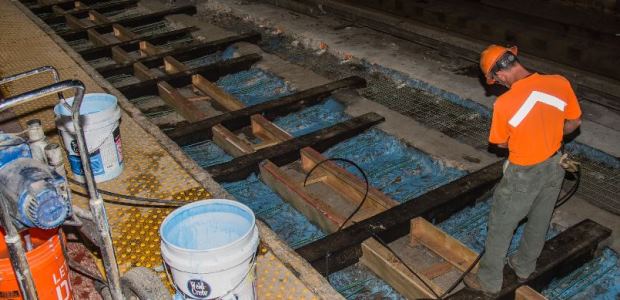
Repair Work Begins at NYC's Penn Station
Amtrak has begun emergency repair work. Meanwhile, MTA Chairman Joe Lhota recently announced a "top-to-bottom" audit of the agency and will propose a plan within 60 days to modernize its subways.
Repair work that is being called "MTA's 'Summer of Hell'" by the New York Post and others began July 10 at New York City's Penn Station, with MTA Chairman Joe Lhota saying the morning rush hour went well because riders took the agency's advice and left for work earlier than usual to avoid delays. Still, Lhota recently announced a "top-to-bottom" audit of the agency and will propose a plan within 60 days to modernize its subways, so this may be only the beginning.
This was emergency repair work by Amtrak at Penn Station, work that will cause service disruptions for about 10,000 customers who ride MTA's Long Island Rail Road during weekday rush hours. LIRR describes the Amtrak "Infrastructure Renewal" at the station as part of a series of major projects that will strengthen and improve operations and preparedness there.
Amtrak President and CEO Wick Moorman announced them in April 2017. "After only a short time here at Amtrak, it has become apparent to me that we need to accelerate major renewal work in New York Penn Station," said Moorman, who became CEO in September 2016. "Using our limited resources, we have made this renewal project a priority to ensure the continuity of travel in the region. Without these improvements, Amtrak, NJ TRANSIT, and the Long Island Rail Road could continue to see major disruptions, which could also have an impact on passenger safety."
New York Penn Station is the country's busiest rail station and transportation facility.
"We at Amtrak understand the steps that must be taken to ensure a safe and reliable railway and will be working throughout the summer and beyond to make the required improvements. We will be collaborating with our partners at NJT and the LIRR to plan this work in order to minimize disruptions and inconvenience for our customers who rely on us for service," Moorman added. "The simple fact of the matter is that some of the track and infrastructure in service today at Penn Station was built in the 1970s at a time when we were handling half the trains and a third of the customers that we do today. While a substantial amount of reconstruction has already been done at New York Penn Station, the remaining renewal work has been scheduled to take place over the next several years in order to minimize impacts on scheduled services. We can't wait that long. This work needs to be done now."
"Millions of New Yorkers depend on the MTA every day, and we must rebuild confidence in the authority with a complete overhaul of the system – identifying the root causes of our problems and taking immediate and decisive action to fix them. It is our responsibility to transport people as safely, quickly and efficiently as possible, and the current state of the subway system is unacceptable," Lhota said June 29 as he promised the audit and modernization plan. The New York City Subway, among the largest and busiest public transit systems in the world, has 472 stations along 665 miles of track and serves nearly 6 million riders per day.
MTA also announced a Genius Transit Challenge, an international competition seeking innovative solutions to modernize and improve the reliability of the New York City subway system. The competition will award a "genius" prize of up to $1 million for the best idea in each of the following categories:
- Improve Signaling in the New York City Subway System: Accelerate deployment of modern train signaling technologies to the subway system, to increase the number of trains at peak periods and promote faster and more reliable service
- Rapidly Deploy Modernized Subway Cars to the Subway System: Obtain and deploy modern subway cars more efficiently, or refurbish existing cars in order to increase the New York City subway system's capacity and reliability, prevent car breakdowns, and reduce delays
- Increase Communications Infrastructure in the Subway System: Identify communications systems that will support rapid installation and deployment of modern train communications and control technologies in the subway system, to increase the subway system’s capacity and reliability